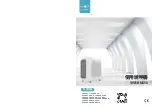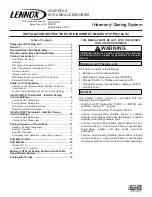
11 User interface
Installation and operation manual
26
5TMV1B
VRV IV-S system air conditioner
4P399985-1B – 2015.06
11
User interface
CAUTION
Never touch the internal parts of the controller.
Do not remove the front panel. Some parts inside are
dangerous to touch and appliance problems may happen.
For checking and adjusting the internal parts, contact your
dealer.
This operation manual will give a non-exhaustive overview of the
main functions of the system.
Detailed information on required actions to achieve certain functions
can be found in the dedicated installation and operation manual of
the indoor unit.
Refer to the operation manual of the installed user interface.
12
Operation
12.1
Operation range
Use the system in the following temperature and humidity ranges for
safe and effective operation.
Cooling
Heating
Outdoor
temperature
–5~46°C DB
–20~21°C DB
–20~15.5°C WB
Indoor
temperature
21~32°C DB
14~25°C WB
15~27°C DB
Indoor humidity
≤80%
(a)
(a)
To avoid condensation and water dripping out of the unit. If
the temperature or the humidity is beyond these conditions,
safety devices may be put in action and the air conditioner
may not operate.
Above operation range is only valid in case direct expansion indoor
units are connected to the VRV IV-S system.
Special operation ranges are valid in case of using AHU. They can
be found in the installation/operation manual of the dedicated unit.
Latest information can be found in the technical engineering data.
12.2
Operating the system
12.2.1
About operating the system
▪ Operation procedure varies according to the combination of
outdoor unit and user interface.
▪ To protect the unit, turn on the main power switch 6 hours before
operation.
▪ If the main power supply is turned off during operation, operation
will restart automatically after the power turns back on again.
12.2.2
About cooling, heating, fan only, and
automatic operation
▪ Changeover cannot be made with a user interface whose display
shows
"change-over under centralised control" (refer to
installation and operation manual of the user interface).
▪ When the display
"change-over under centralised control"
flashes, refer to
"12.5.1 About setting the master user
interface" on page 27
.
▪ The fan may keep on running for about 1 minute after the heating
operation stops.
▪ The air flow rate may adjust itself depending on the room
temperature or the fan may stop immediately. This is not a
malfunction.
12.2.3
About the heating operation
It may take longer to reach the set temperature for general heating
operation than for cooling operation.
The following operation is performed in order to prevent the heating
capacity from dropping or cold air from blowing.
Defrost operation
In heating operation, freezing of the outdoor unit's air cooled coil
increases over time, restricting the energy transfer to the outdoor
unit's coil. Heating capability decreases and the system needs to go
into defrost operation to be able to deliver enough heat to the indoor
units:
The indoor unit will stop fan operation, the refrigerant cycle will
reverse and energy from inside the building will be used to defrost
the outdoor unit coil.
The indoor unit will indicate defrost operation on the displays
.
Hot start
In order to prevent cold air from blowing out of an indoor unit at the
start of heating operation, the indoor fan is automatically stopped.
The display of the user interface shows
. It may take some
time before the fan starts. This is not a malfunction.
12.2.4
To operate the system
1
Press the operation mode selector button on the user interface
several times and select the operation mode of your choice.
Cooling operation
Heating operation
Fan only operation
2
Press the ON/OFF button on the user interface.
Result:
The operation lamp lights up and the system starts
operating.
12.3
Using the dry program
12.3.1
About the dry program
▪ The function of this program is to decrease the humidity in your
room with minimal temperature decrease (minimal room cooling).
▪ The micro computer automatically determines temperature and
fan speed (cannot be set by the user interface).
▪ The system does not go into operation if the room temperature is
low (<20°C).
12.3.2
To use the dry program
To start
1
Press the operation mode selector button on the user interface
several times and select
(program dry operation).
2
Press the ON/OFF button of the user interface.
Result:
The operation lamp lights up and the system starts
operating.
3
Press the air flow direction adjust button (only for double-flow,
multi-flow, corner, ceiling-suspended and wall-mounted). Refer
to
"12.4 Adjusting the air flow direction" on page 27
for details.
To stop
4
Press the ON/OFF button on the user interface once again.







































